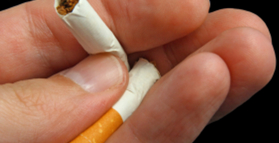 How to quit smoking
How to quit smoking
Posted on Sun, 19 Dec 10

Smoking is responsible for 1 in 5 deaths and with no level of exposure to cigarette smoke safe the best thing you can do for your health, and those around you, is to stop.
Quitting smoking decreases risk of cancer, heart disease, stroke, and early death. Quitting also benefits the people around you, as many as 75% of non-smokers have a greatly increased risk of heart disease due to passive smoking.
Some recent findings on the hazards of smoking:
- There is no safe level of exposure to tobacco smoke. Any exposure to tobacco smoke – even an occasional cigarette or exposure to secondhand smoke – is harmful.
- Damage from tobacco smoke is immediate. Tobacco smoke contains more than 7,000 chemicals and chemical compounds, which reach your lungs every time you inhale. Your blood then carries the poisons to all parts of your body. These poisons damage DNA, which can lead to cancer; damage blood vessels and cause clotting, which can cause heart attacks and strokes; and damage the lungs, which can cause asthma attacks, emphysema, and chronic bronchitis.
- Smoking longer means more damage. Both the risk and the severity of many diseases caused by smoking are directly related to how long the smoker has smoked and the number of cigarettes smoked per day.
- Cigarettes are designed for addiction. The design and contents of tobacco products make them more attractive and addictive than ever before. Nicotine addiction keeps people smoking even when they want to quit.
- Even low levels of exposure, including exposure to secondhand tobacco smoke, are dangerous. You don’t have to be a heavy smoker or a long-time smoker to get a smoking-related disease or have a heart attack or asthma attack triggered by smoke.
- There is no safe cigarette.
What you can do to quit:
-
Set a quit date, ideally within the next 2 weeks.
-
Be committed. Keep in mind why you want to quit and stay motivated.
-
Get help from a health professional such as your doctor and continue to follow up visits, especially during the first month.
-
Choose a firm date to quit and mark your calendar. Choose a time that is not particularly stressful and that does not involve situations associated with smoking.
-
Begin to cut back prior to your quit date.
-
Consider joining a stop-smoking program.
-
Tell friends, family, and coworkers that you are quitting smoking so that they can offer motivation and support.
-
Remove smoking from your environment. Avoid places where people congregate to smoke. Remove cigarettes from your car, home, and work.
-
Total abstinence will enhance your success — not even a single puff.
-
Avoid alcohol while you are quitting. Drinking alcohol is strongly associated with relapse.
-
Avoid other smokers. Allowing others to smoke in the household hinders successful quitting.
-
Review past quit attempts—what helped, what led to relapse
-
Anticipate that you may experience withdrawal symptoms, such as cigarette cravings, anxiety, irritability, and restlessness. These symptoms usually peak at 1 to 3 weeks after quitting but generally become manageable within a few weeks.
-
Eat healthy and stay active to help with stress and to minimize weight gain.
-
If you relapse the first few times, keep trying. Many ex-smokers try several times, often as many as 8 to 10 times, before they are able to quit for good.
-
Before you consider medications or nicotine replacement consider that going “cold turkey” is the most popular and successful way to quit smoking. The majority of ex-smokers (about 66 to 75%) quit smoking without any assistance.
References:
1. Whincup PH, Gilg JA, Emberson JR, Jarvis MJ, Feyerabend C, Bryant A, Walker M, Cook DG. Passive smoking and risk of coronary heart disease and stroke: prospective study with cotinine measurement. BMJ. 2004; 329: 200–205
2. A Report of the Surgeon General: How Tobacco Smoke Causes Disease: The Biology and Behavioral Basis for Smoking-Attributable Disease. 2010.
3. The Centres for Disease Control. What to Tell Your Patients About Smoking A Report of the Surgeon General: How Tobacco Smoke Causes Disease. Accessed at http://www.cdc.gov/tobacco/data_statistics/sgr/2010/clinician_sheet/pdfs/clinician.pdf on 20/12/2010
4. Brender E, Lynm C, Glass RM. JAMA patient page. Smoking cessation. JAMA. 2010 Dec 8;304(22):2548.
5. Cancer Counsel Australia. Most Australians still quit smoking unassisted. Study confirms preference for ‘cold turkey.’ 8 October 2010. Accessed online at http://www.cancer.org.au/Newsmedia/mediareleases/mediareleases2010/8October2010.htm on 20/12/2010
Tags: Smoking, Cigarettes, Second Hand Smoke, Passive Smoking




